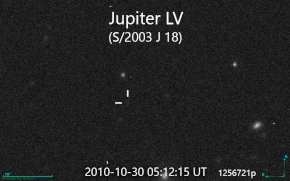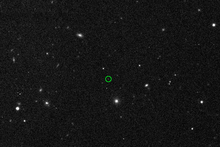 Recovery images of Jupiter LV taken by the Canada-France-Hawaii Telescope in October 2010 | |
| Discovery | |
|---|---|
| Discovered by | Brett J. Gladman |
| Discovery date | 4 April 2003 |
| Designations | |
| S/2003 J 18 | |
| Orbital characteristics [1] | |
| 20274000 km | |
| Eccentricity | 0.0509071 |
| −604.99 d | |
| 220.7° | |
| Inclination | 143.5° (to ecliptic) |
| 215.5° | |
| 98.15° | |
| Satellite of | Jupiter |
| Group | Ananke group |
| Physical characteristics | |
| 2 km | |
| 23.4 | |
Jupiter LV, provisionally known as S/2003 J 18, is a natural satellite of Jupiter. It was discovered by a team of astronomers led by Brett J. Gladman in 2003.[2][3]
Jupiter LV is about 2 kilometres in diameter, and orbits Jupiter at an average distance of 20.220 Gm in 604.99 days, at an inclination of 143° to the ecliptic (145° to Jupiter's equator), in a retrograde direction and with an eccentricity of 0.0509.[4]
It belongs to the Ananke group, retrograde irregular moons that orbit Jupiter between 22.8 and 24.1 Gm, at inclinations of roughly 150-155°.

The moon was lost following its discovery in 2003.[5][6][7][8] It was recovered in 2017 and given its permanent designation that year.[9]
- ^ S.S. Sheppard (2019), Moons of Jupiter, Carnegie Science, on line
- ^ Daniel W. E. Green (11 April 2003). "IAUC 8116: Satellites of Jupiter and Saturn". International Astronomical Union.
- ^ MPEC 2003-G20: S/2003 J 18 4 April 2003 (discovery)
- ^ MPEC 2017-L09: S/2003 J 18 2 June 2017 (recovery and ephemeris)
- ^ Beatty, Kelly (4 April 2012). "Outer-Planet Moons Found — and Lost". www.skyandtelescope.com. Sky & Telescope. Retrieved 27 June 2017.
- ^ Brozović, Marina; Jacobson, Robert A. (9 March 2017). "The Orbits of Jupiter's Irregular Satellites". The Astronomical Journal. 153 (4): 147. Bibcode:2017AJ....153..147B. doi:10.3847/1538-3881/aa5e4d.
- ^ Jacobson, B.; Brozović, M.; Gladman, B.; Alexandersen, M.; Nicholson, P. D.; Veillet, C. (28 September 2012). "Irregular Satellites of the Outer Planets: Orbital Uncertainties and Astrometric Recoveries in 2009–2011". The Astronomical Journal. 144 (5): 132. Bibcode:2012AJ....144..132J. doi:10.1088/0004-6256/144/5/132. S2CID 123117568.
- ^ Sheppard, Scott S. (2017). "New Moons of Jupiter Announced in 2017". home.dtm.ciw.edu. Retrieved 27 June 2017.
We likely have all of the lost moons in our new observations from 2017, but to link them back to the remaining lost 2003 objects requires more observations a year later to confirm the linkages, which will not happen until early 2018. ... There are likely a few more new moons as well in our 2017 observations, but we need to reobserve them in 2018 to determine which of the discoveries are new and which are lost 2003 moons.
- ^ Sheppard, Scott S. (2017). "Jupiter's Known Satellites". home.dtm.ciw.edu. Archived from the original on 20 July 2017. Retrieved 10 August 2017.